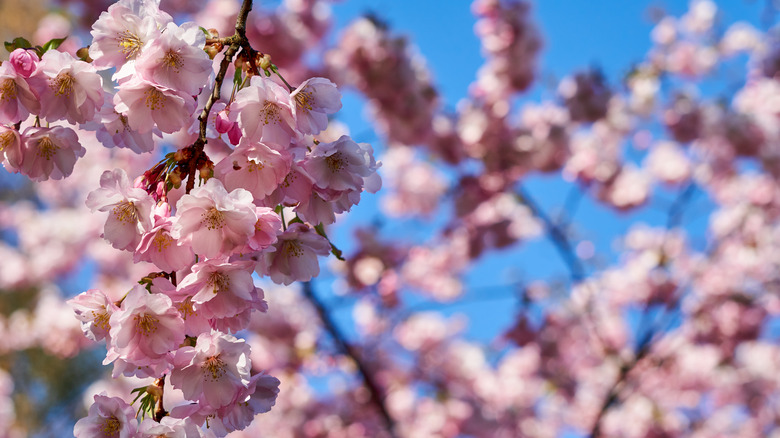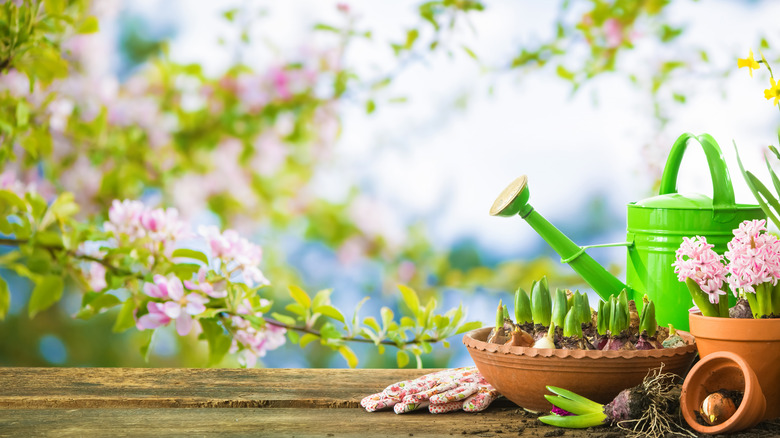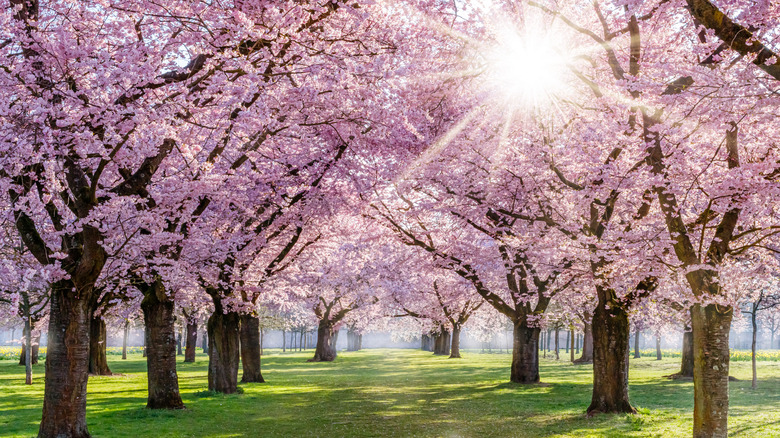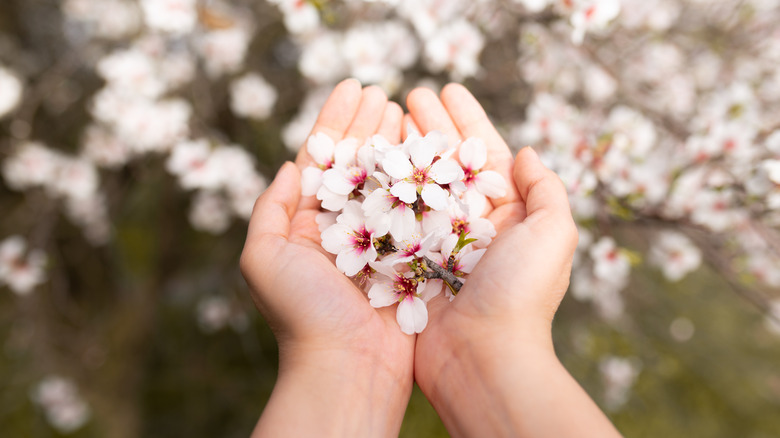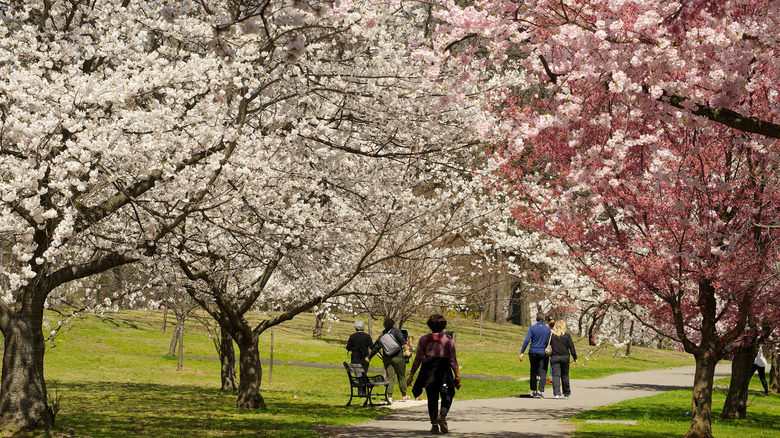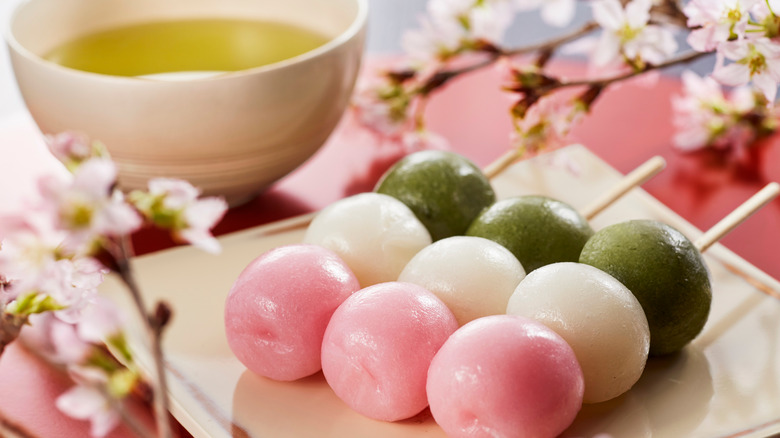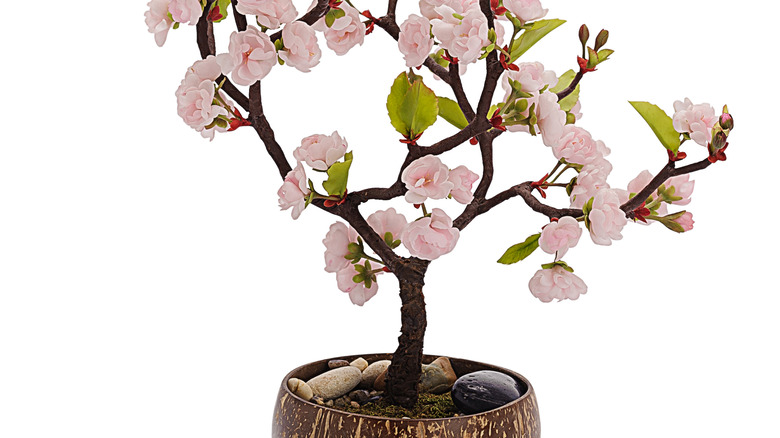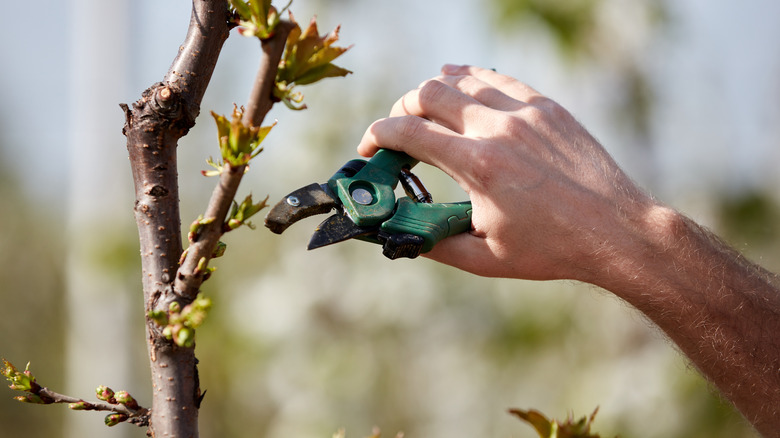Cherry Blossoms: Everything You Need To Know Before Planting
Enchanting and ancient, cherry blossoms (Prunus serrulata) have been a distinctive symbol of spring and restoration for centuries. Commonly linked with Japanese art and culture, the flowering cherry blossom tree, or Sakura, is an awe-inspiring beauty often used as a decorative display in gardens, landscapes, parks, and borderlines around the globe. A national symbol of Japan, cherry blossoms actually originated centuries ago in China's Himalayan territory and was initially introduced to Japan during the Tang Dynasty (618 – 907), per China Daily. Cherry blossom trees were first presented to the United States in 1912. Tokyo's Mayor Yukio Ozaki granted approximately 3,000 cherry blossom trees to the nation's capital of Washington D.C. to signify the friendship between Japan and the U.S. (via Arlington National Cemetery Tours).
Why plant cherry blossom? When these flowering trees bloom, they add an aesthetic quality to your springtime garden unlike any other tree. According to Japan-Guide.com, many wild cherry blossoms, including some cultivated varieties, show flowers with five petals, although some have 10 or more like the late-blooming yaezakura. The flowers of the cherry blossom often bloom in an assortment of pink hues and white tones, and do not generally produce fruit. Lovely and ornamental, cherry blossom trees grow between 20 and 40 feet high with canopies that may spread 15 to 30 feet wide and can live up to 40 years. Read on to learn more about how to cultivate your own cherry blossom trees!
How to use cherry blossoms in the garden
Cherry blossom trees develop in subtropical to temperate locations worldwide, but it's important to know the USDA zone you reside in before attempting to establish one. With hundreds of varieties, cherry blossoms have acclimated to zones 5 to 8 in the United States, as per The Tree Center. Cherry blossoms prosper in rich, fertile soil that drains well. A way to attain this is to place your tree on a higher ground level instead of a low-lying section. A true centerpiece, your Sakura will elegantly fill a space in any garden landscape that suits its estimated growth size and planting conditions.
Although, if you don't want your tree as visible in the off-season when it appears less lively, you might want to plant it to the side of your lawn. Cherry blossoms are deciduous plants in which they lose their leaves for a portion of each year. The blooming season extends to about a month at a time, but the flower itself is rather fleeting (up to a week). Also, try including it with other flowering trees or shrubs. This will help balance the appearance of your garden blooms with those plants that bud earlier and those later. Wherever you decide, make sure to place it where it will receive at least 6 hours of direct sunlight each day. They can survive in partial shade but thrive in direct, unfiltered sunlight.
How to grow cherry blossoms
Cherry blossom trees are relatively low maintenance to grow and maintain. This is because your cherry blossom tree thrives in various soil conditions, including sandy, loamy, or clay (acidic or alkaline), per The Tree Center. However, it's prone to root rot and won't like being soaked, so make sure the soil is well-draining. When planting, make sure to place it 10 to 20 feet from other plants, trees, and foliage, including other buildings or structures. Even though the flowering tree needs lots of direct sunlight, it's mildly drought tolerant. If location options are limited, partial shade is tolerable.
When should your cherry blossom be planted? To ensure your tree's longevity, plant after the last frost (via Garden Design). Dig a hole as deep as the tree's root ball or container, then dig around twice as much as its width. After placing it in the ground, make sure the crown of its roots is even with the surface of the dirt. You might try scattering a thick layer of mulch around the base to help retain water intake (3 to 4 inches). This will comfort your cherry blossom during dry spells while keeping those bothersome weeds away. If the soil is mostly clay, add some organic matter like compost or peat within the dirt or on the surface. You might attach a tree stake for extra support to keep it sturdy while becoming established.
How to care for cherry blossoms
No more than light upkeep is necessary once you've established your cherry blossom tree, although paying attention to its watering requirements is essential. Water thoroughly every other day during the initial week it's planted to support its foundation. In the second week, soak it entirely two to three times. Then, give it a thorough drink consistently each week for the duration of its first season, per Gardening Know How. From there, your cherry blossoms should thrive on rainwater.
Pruning your cherry blossom tree is a prosperous act. Establish the tree's expected shape and size by pruning it in the dry, dormant season; you can start after its first blooms appear. First, remove any broken, rotted, or dead limbs present. Use a sharp pair of shears, clippers, or loppers, and a pruning saw if obtainable. Clip back to the branch collar without damaging the bark around the original cut. Limit the pruning after a few years, as this will prompt more growth than needed, per Green Garden Guy. What about fertilizer? Fertilizing your ornamental cherry tree truly depends upon the fruitfulness of the soil and the tree's maturity. If you think your soil lacks any nutrients, SF Gate suggests getting a soil test. This will determine which nutrients might need to be supplemented. For slow growth, use a low-nitrogen fertilizer. Adding too much nitrogen may damage the roots and cause the tree to grow greens rather than blossoms.
Cherry blossom varieties
Several species of cherry blossom trees flower, and they yield diversified blossoms. According to Portland Nursery, they are part of the larger genus group Prunus spp., which includes almonds, apricots, cherries, peaches, and plums. Ornamental "flowering cherries" are grown in the United States, and do not generally produce fruit. These are five of the most common cherry blossom tree varieties:
- Somei Yoshino "Yoshino Cherry" (Prunus x yedoensis) – With rich pink petals, this is the most popular and widely planted Japanese cultivar. Garden Design notes it grows well in chilled climates (zones to 5 to 8).
- Kanzan( Prunus serrulata) – This is a popular Japanese cherry cultivar often seen in Washington D.C. along with the Yoshino. Susceptible to disease, it is short-lived (15 to 25 years), yet has large blooms with deep pink petals.
- Yamazakura (Prunus jamasakura) – Also known as Mountain Blossom, this cherry blossom grows naturally in the wild and blooms delicate pink/white flowers with five petals.
- Kiku-shidare-zakura (Prunus serrulata) – This cherry blossom's name translates from Japanese as "weeping chrysanthemum cherry" (via Gardenia). It produces charming pink layers of blossoms in mid to late spring.
- Yaezakura (Prunus serrulata) - Also known as Double Blossom, this Sakura is a late bloomer with two layers of petals, between 10 to 50. The colors vary from brilliant white to vibrant pink. Blooms two to four weeks after most five-petaled categories.
Are cherry blossoms toxic?
At the end of March into the beginning of April, you'll see your cherry blossoms start to bloom. But are they toxic to consume? For dogs, the answer is definite. Experts at Dog of the Day emphasize that all parts of the tree, including the blossoms, leaves, and stems are noxious to dogs. Prunus serrulata contains cyanogenic glycosides, a toxin that prevents oxygen from being transported to the cells properly. Look for signs of dilated pupils, bright red gums, vomiting, muscle weakness, or difficulty breathing (via Pet Poison Helpline). If so, take them to the vet as soon as possible.
This goes for cats as well. The cherries themselves may be fine, but cyanide poisoning from other parts of the tree can be present 15 to 20 minutes after consumption. As for humans, the same toxicity risks apply. On the other hand, humans can enjoy the delicate flavor of the Japanese cherry blossom itself through different sweets, teas, and cocktails, including various mochi cakes and cookies. As for consuming actual cherries, flowering cherry blossom trees are planted more for their appearance rather fruit production, notes Country Living. And, although some produce fruit closely related to edible cherries, these trees are still usually grown more for splendor.
How to repot cherry blossoms
Cherry blossoms are not generally used as house plants, but all things are possible. If you decide to grow yours in a pot, you might place it on an open balcony or terrace. Any further inside, consider a smaller bonsai or dwarf variety. When should you repot? Signals of readiness may be because it's not looking as healthy as it began, or the roots are visibly growing out the bottom of the pot. The Spruce recommends repotting in the springtime before it has officially bloomed. This will give your tree time to strengthen its root system earlier on. Doing it in the winter may also assist in maintaining the well-being of the roots. Whenever you decide, make sure to water it a couple days prior to transplanting.
Use a deep, well-draining pot that is twice the size of the original. Loosen the soil around the tree and pull out the base carefully. Add soil to the bottom along with organic compost, if available. Water it through and continue for the first several weeks. Be sure to include as much of the root ball as possible. Bonsai Boy suggests raking back some of the soil to help prune the roots (no more than a ¼ of the tree's root mass). Repotting your tree will supply it with renewed energy and a solid base.
Keeping your cherry blossom healthy
Again, light pruning is acceptable in the summer, but the best time is in the winter, although too much trimming may be damaging. According to LawnStarter, several Prunus trees and shrubs like cherry blossoms can become affected by various tree diseases like silver leaf fungus. Most often, this affects cherry blossom trees because of too much pruning. Look for a gray or silver layer on the leaves. Remove the infected branches or areas as soon as you can. Prune at least 4 inches below from where the fungus exists. Another ailment cherry blossoms may deal with is black knot fungus. This appears as black gall swellings or knots. The knots often spread in the spring and are usually caused by windy and rainy weather. To help treat black knot fungus, cut away the branches and limbs where the knots are visible to the same depth of 4 inches. Burn the pieces after removal to prevent any further spread of the disease, advises Gardening Know How.
Other fungi-related issues might include blight, canker, and powdery mildew. Also, be aware of pests and insects that might injure your cherry blossom. Aphids, scales, and spider mites are known to battle against the "Kwanzan" cherry blossom. SF Gate suggests hosing them off with water; no chemical treatment is needed. Draw lacewings, wasps, and ladybugs near to feed on the unwanted visitors.
